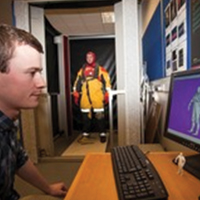 North Sea Offshore 3D Body Scanning Project Launched.
North Sea Offshore 3D Body Scanning Project Launched.
Groundbreaking research to measure offshore workers’ body size with 3D scanners to inform the future design of safety equipment, survival clothing and space requirements on offshore installations has been launched by researchers at Robert Gordon University in Aberdeen, in collaboration with experts from Oil and Gas UK.
The research will generate an ongoing capability for measuring the size and shape of the offshore workforce, and is (Read More)
the first of its kind in more than 25 years. Researchers from Robert Gordon University’s Institute of Health and Welfare Research (IHWR) aim to design and implement a systematic assessment of three-dimensional measurements on a sample of around 600 offshore workers. The data will then be used to inform all aspects of offshore ergonomics and health and safety, from emergency helicopter evacuation and survival suit design to space availability in corridors and work environments. Project leaders are Dr Arthur Stewart, Reader, and deputy director of RGU’s Centre for Obesity Research and Epidemiology (CORE), and Dr Graham Furnace, Medical Advisor for Oil & Gas UK. Dr Stewart said: “The last body size survey of offshore workers was undertaken in the mid 1980s and since then the average weight of the workforce has risen by 19%. As a consequence the size and shape of the offshore workforce has increased to an unknown level. “Understanding this change in size and space requirements for the offshore workforce is important as their current workplace is designed for personnel as they were a quarter of a century ago. Knowing the actual size of the workforce, together with size increments imposed by different types of clothing, will enable space-related risk to be managed and future design for space provision optimised.” More than £150,000 in funding for the project was secured through a combination of a Technology Strategy Board Knowledge Transfer Partnership Grant as well as support from several Oil & Gas UK member companies. Aberdeen company Survival One (Survitek Group) has also donated a number of the very latest survival suits for use in the project. KTP Associate Robert Ledingham has been appointed to work on the study and will test and calibrate new portable 3D scanning technology at the University’s Centre for Obesity Research and Epidemiology where the first group of volunteers will be scanned before using it to gather more data at Falck Nutec’s offshore training facility in Dyce. Initial research conducted by the team at RGU has shown that a 90kg man wearing a standard helicopter passenger survival suit increases body volume by 44 litres over that of close fitting clothing. Graham Furnace said: “It is already known that the majority of the UK population is overweight, and offshore workers are no different in this respect. The question of ‘big people’ is a major area of medical concern within the industry because of the health risks associated with being overweight, but as the initial scans of the study already confirm, the issues relating to the size and shape of offshore workers also have important safety and equipment design implications.”

